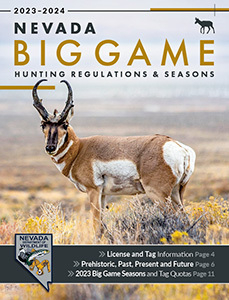Department of Wildlife Regional Offices & Commissioners

Western Region Office
1100 Valley Rd.
Reno, NV 89512
(775) 688-1506
Eastern Region Office
60 Youth Center Rd.
Elko, NV 89801
(775) 777-2300
Southern Region Office
3373 Pepper Lane
Las Vegas, NV 89120
(702) 486-5127
Ely Office
1218 N. Alpha St.
Ely, NV 89301
Phone: (775) 289-1655 ext. 21
(Hours subject to change, please call ahead.)
Fallon Office
380 West B. St.
Fallon, NV 89406
(775) 423-3171
(Hours subject to change, please call ahead.)
Winnemucca Office
705 E. Fourth St.
Winnemucca, NV 89445
(775) 623-6565
(Hours subject to change, please call ahead.)
Chronic Wasting Disease
Please do your part to help keep Nevada free of Chronic Wasting Disease.
It is now illegal (2019 SB85) to bring a big game carcass into Nevada from another state unless it’s been cleaned and is completely free of the spinal column and brain tissue.
Acceptable to transport: Meat, quarters with leg bones, skull-capped antlers and horns, capes and skins, taxidermy mounts, and teeth. Intact skulls are allowed only if they’ve been boiled, beetle-stripped, or otherwise completely cleaned of brain tissue.
To get your animal tested please visit your local NDOW office or visit www.ndow.org. For more information, visit www.cwd-info.org.

Español
Haga su parte para ayudar mantener el estado de Nevada libre de la enfermedad de desgaste crónico. Es ilegal (2019 SB85) traer un cadáver de caza a Nevada desde otro estado al menos que haya sido limpiado y esté completamente libre de la columna vertebral y de tejido cerebral. Es aceptable el transporte de carne, cuartos con huesos de piernas, astas y cuernos con casquetes, capas y pieles, monturas de taxidermia, y dientes. Los cráneos intactos solo se permiten si han sido hervidos, despojados de escarabajos o completamente limpios de tejido cerebral.
BLM Information
The Bureau of Land Management (BLM) in Nevada encourages hunters to call in advance of hunting season to find out if land management practices will be conducted during the hunting season. While BLM field offices are aware of hunting seasons, some management activities, such as prescribed burns, wild horse gathers, road closures or fire restrictions may temporarily disrupt hunting activities.
Call Before You Hunt
If possible, call the appropriate BLM office before you send in your hunt area requests. That way you may avoid an area that may have some access restrictions or other changes because of management activities. It’s a good idea to call BLM just before the hunt to find out if any unplanned restrictions from fire or emergency wild horse gathers are in effect.
- Battle Mountain District Office
(775) 635-4000 - Carson City District Office
(775) 885-6000 - Elko District Office
(775) 753-0200 - Ely District Office
(775) 289-1800 - Southern Nevada District Office
(702) 515-5000 - Winnemucca District Office
(775) 623-1500
Responsible Hunting in Wilderness and Wilderness Study Areas (WSAs)
Some units contain BLM lands designated as wilderness or wilderness study areas. Motor vehicle use—trucks, ATVs and motorcycles—is not allowed unless signs are placed to indicate a designated route. The motorized vehicle rule extends to mechanized vehicles such as game carriers, which are also not allowed in these areas. Hand-held GPS units are allowed.
Responsible Off-Highway Vehicle Use
There has been a big increase in the use of OHVs by hunters. While most areas of the public lands are designated as open to OHV use, cross-country travel on OHVs is causing unnecessary damage to habitat that wildlife depend on. OHV riders are asked to stay on existing roads and trails. If it is necessary to drive off roads to retrieve and pack out harvested game, hunters are asked to use care and avoid creating new routes.
Big Game Hunt Survey
Hunt surveys must be submitted for all big game tags regardless of successful harvest. Questionnaires must be submitted on or before 5 p.m. PST on January 31 following the close of the hunt season for which the tag was issued. Hunts that close after January 31 must be submitted on or before 5 p.m. PST on February 28.
Hunt survey questionnaires may be submitted through a customer’s account at ndowlicensing.com by clicking the Surveys link.
Successful tag holders who fail to report a harvest return card will be subject to a $50 penalty and a suspension from the next season’s application period until the penalty is paid and the questionnaire completed. (Refer to NAC 502.405)
Nevada Testing and Training Range (NTTR)
United States Air Forces NTTR lands provide a unique, likely once in a lifetime, desert bighorn sheep hunting experience. Since the inception of the NTTR in 1940, these lands have remained relatively undisturbed allowing bighorn sheep to persist through time. Hunters are required to pass a criminal background check, submit a full inventory of their equipment, and take part in a mandatory safety briefing prior to accessing withdrawn lands.
The 2022 hunt season saw multiple violations during the NTTR hunts that lead the air force to threaten closing the hunt into the future. To allow the hunt to persist, the Department and Desert National Wildlife Refuge agreed to additional restrictions.
The NTTR made it very clear that if there were any more violations, they would pursue closing the hunt in perpetuity.
If you are interested in applying for these hunts please take this process seriously.
Illegal Outdoor Marijuana
The past year has shown an increase in illegal outdoor marijuana grow gardens in the Nevada outback. Sportsmen should be aware of their surroundings while utilizing the outdoors. If you observe remote camp sites/ irrigation equipment/marijuana plants leave the area immediately.
Note the location of suspicious activity and contact law enforcement officials. Game wardens work in conjunction with other law enforcement agencies when these grow gardens are found to apprehend the growers, eradicate the plants and rehabilitate the damaged environment.
Operation Game Thief 1-800-992-3030
or DPS 1-866-2REPORT or NDOW Tip App.

